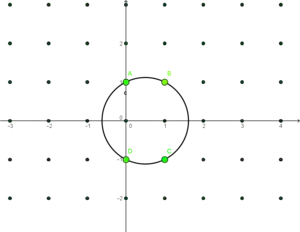In the geometry of numbers, Schinzel's theorem is the following statement:
Schinzel's theorem — For any given positive integer , there exists a circle in the Euclidean plane that passes through exactly integer points.
It was originally proved by and named after Andrzej Schinzel.[1][2]
Proof

Schinzel proved this theorem by the following construction. If is an even number, with , then the circle given by the following equation passes through exactly points:[1][2]
This circle has radius , and is centered at the point . For instance, the figure shows a circle with radius through four integer points.
Multiplying both sides of Schinzel's equation by four produces an equivalent equation in integers,
This writes as a sum of two squares, where the first is odd and the second is even. There are exactly ways to write as a sum of two squares, and half are in the order (odd, even) by symmetry. For example, , so we have or , and or , which produces the four points pictured.
On the other hand, if is odd, with , then the circle given by the following equation passes through exactly points:[1][2]
This circle has radius , and is centered at the point .
Properties
The circles generated by Schinzel's construction are not the smallest possible circles passing through the given number of integer points,[3] but they have the advantage that they are described by an explicit equation.[2]
References
- 1 2 3 Schinzel, André (1958), "Sur l'existence d'un cercle passant par un nombre donné de points aux coordonnées entières", L'Enseignement mathématique (in French), 4: 71–72, MR 0098059
- 1 2 3 4 Honsberger, Ross (1973), "Schinzel's theorem", Mathematical Gems I, Dolciani Mathematical Expositions, vol. 1, Mathematical Association of America, pp. 118–121
- ↑ Weisstein, Eric W., "Schinzel Circle", MathWorld